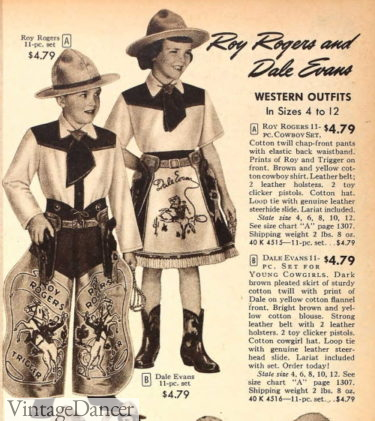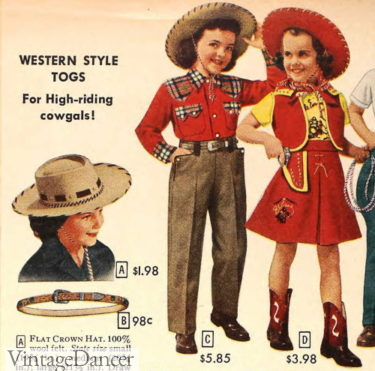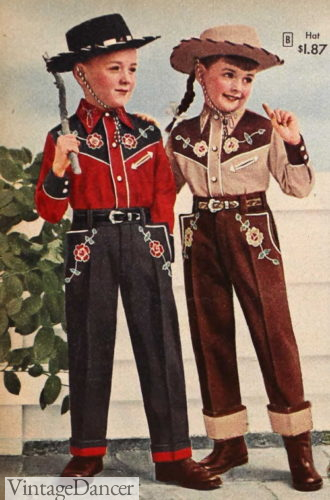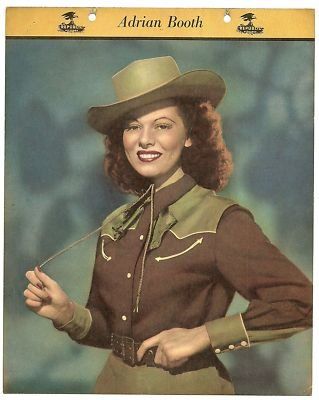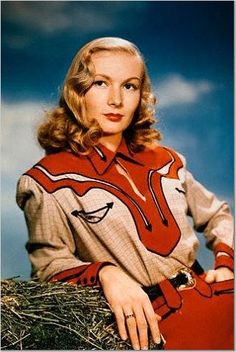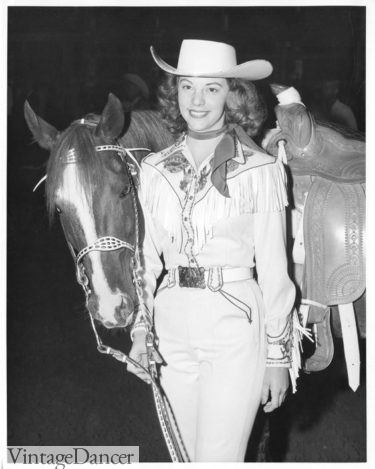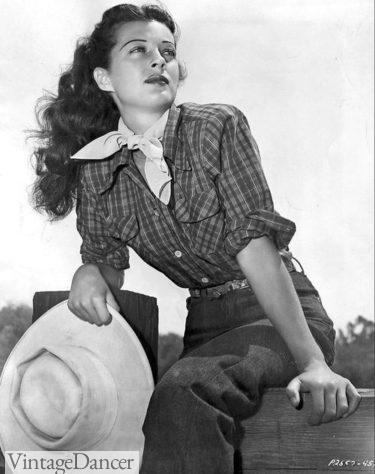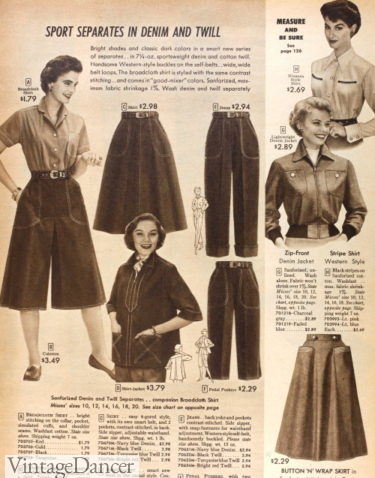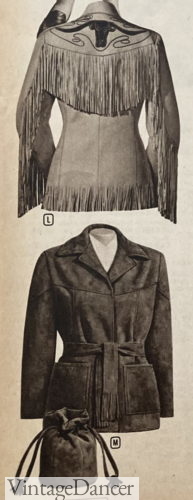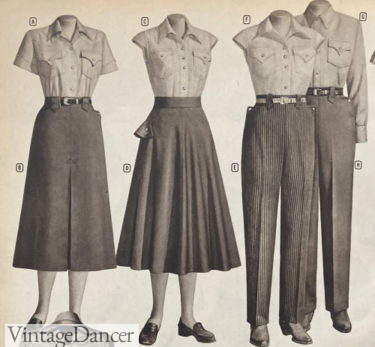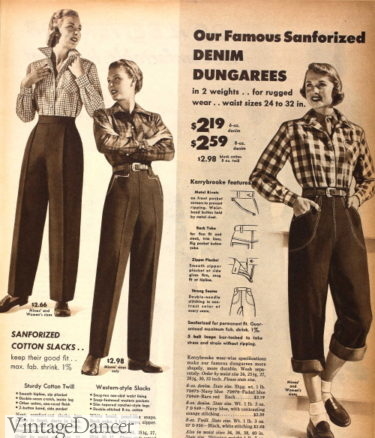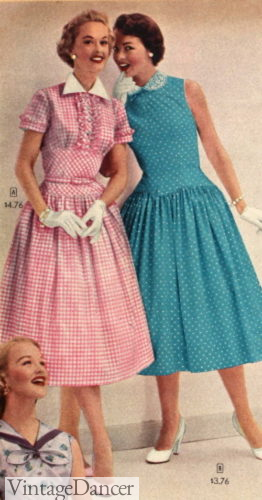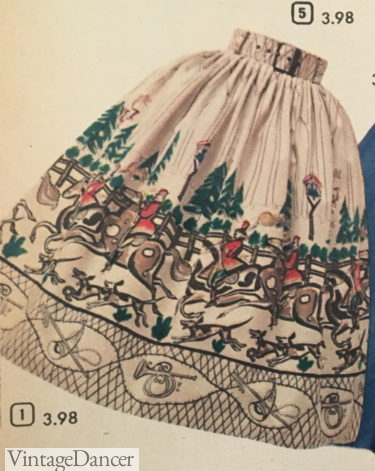Western wear served as the roots for denim jeans, plaid shirts, cowboy boots, and hats. The look hasn’t changed much in the last 100 years, but there was a time in the mid-century where practical westernwear met mainstream fashion and created trendy new styles. It is a part of fashion history that seems to get ignored, yet how could we ignore it?
Men’s vintage western wear has moved here.
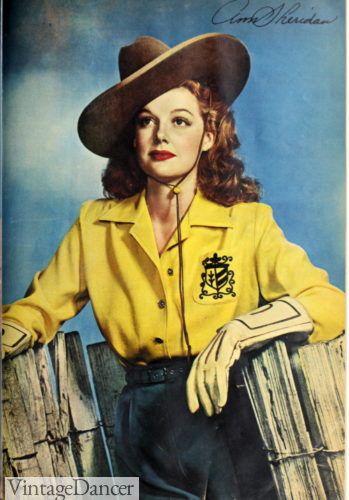
1942 Ann Sheridan
Flipping through my vintage clothing catalogs, I see almost every men’s and women’s shirts and jeans had details clearly taken from working class/ranch-hand/ wild west United States traditional clothing. Why was it so popular? When did these new style begin? Why were the 1950s the epitome of vintage western clothing? Let’s take a look and see.
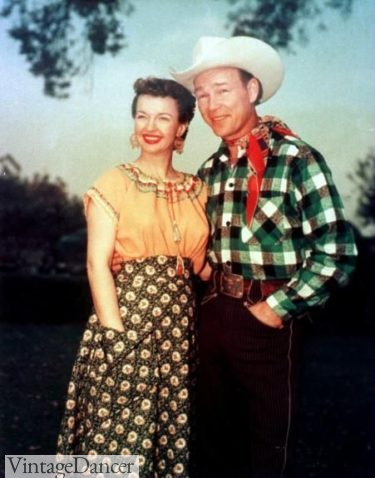
Roy Rogers and Dale Evans 1950s
Western Wear Goes Hollywood
The late 1920s to 1950s is known as the heyday of western style clothing. The mass migration out west and the discovery of rich farming and cattle land in California was mostly complete by the 1930s. Hollywood established itself not in the hustle and bustle of big city life, but in the quiet desert of Southern California surrounded by rolling hills and cattle farms.
Despite whatever actors and actresses portrayed on TV, at home they often found peace in a California ranch home. It didn’t matter if they raised horses or cattle, they lived in homes and dressed as casual as the working class farmers.
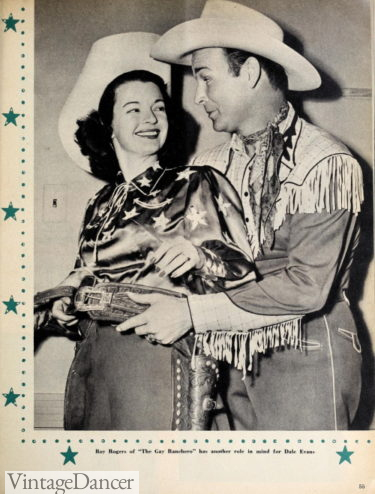
1947 Roy Rogers and Dale Evans, leading western stars
It was only a matter of time before home life became screen life. Black and white “Western” movies and TV shows captured life “out in the Wild West” chasing outlaws on horseback. Fictional plots no less, but the fascination with this rough life was felt by adults and children.
The clothing industry catered to this with replica western clothing for children long before the trend took off for adults. Sears had a line of “Roy Rogers” and “Dale Evans” outfits for girls and boys. There were also Dale Evans watches, sweaters, school book bags, hats and socks.
- 1953 Roy Rogers and Dale Evens outfits at Sears
- 1952 girls western clothes
- 1957 Western Outfits for Children
1920s and 1930s Western Clothing
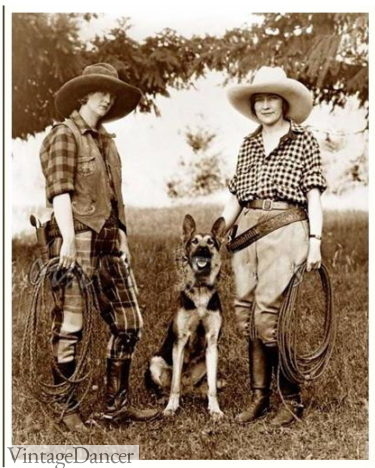
Real women’ ranchers, 1920s
Outside of TV, live rodeo was a major interest beginning in the late 1920s. Both men and women were rodeo stars with their fast mounts, faster quick draws, fancy chaps, fringe shirts, and rhinestone sparkling hats and belt buckles. These flashy Rodeo star looks were the inspiration of 1930s and 1940s western wear with little distinction between men’s and women’s styles.
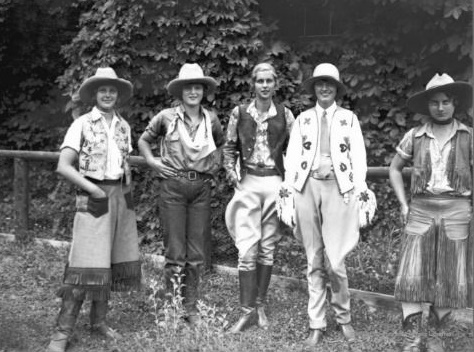
1930s dude ranch western outfits
Both wore breeches or denim jeans, button up shirts, cowboy boots, and large hats. Colors were very bright and flashy. Various shades of tanned leather were dripping in fringe, sequins, embroidery, and beads. Native American jewelry and motifs were common accessories.
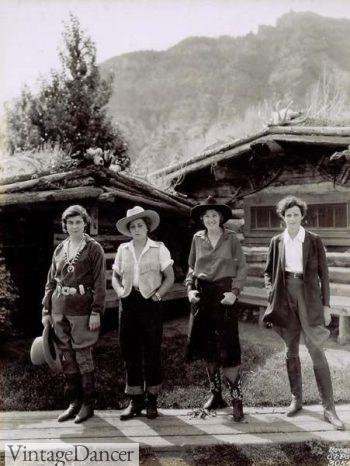
Early 1930s Fred Harvey Indian Detours tour led by Courier/guide, Diane Thomas. Read more about them here. She wears a uniform of velvet tunic with concho belt and squash blossom necklace, and the Western hat.
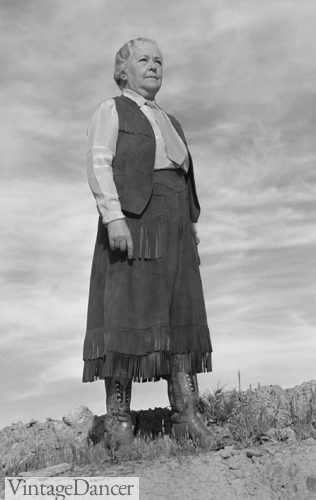
1939 Mrs. Arnold at Quarter Circle U Ranch in Montana wears a fringe skirt and vest
A popular vacation for the middle classes was to a working dude ranch, where vacationers dressed the part. Some loved their clothes so much that they continued to wear them at home.
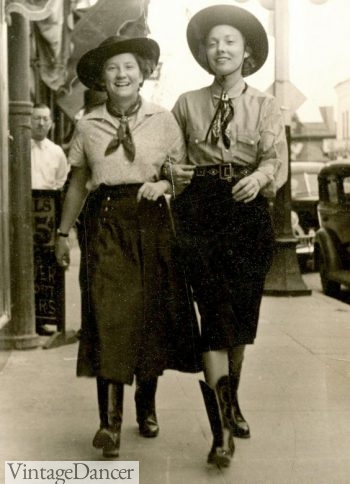
1930s Western Wear on the Street
Women’s riding clothes / working ranch clothing was already in the western style. Learn more about women’s 1930s riding breeches and pants.
1940s Western Wear
Rodeo cowgirls Tad Lucas and Lucyle Richards were frequently in the spot light. Their vast wardrobes inspired what Hollywood and real women wore in the 1940s.
- Adrian Booth
- Veronica Lake
- Rodeo star (name unknown.)
- Gail Russell
Western prints such as gingham, paisley, and plaid were made into dresses, shirts, and accessories. Most were made just for leisure, work, or play clothes. Women’s riding clothes remained traditional cuts with a bit more design and dazzles on shirts. Pants too often had piping, shaped pockets, and embroidered back pockets.
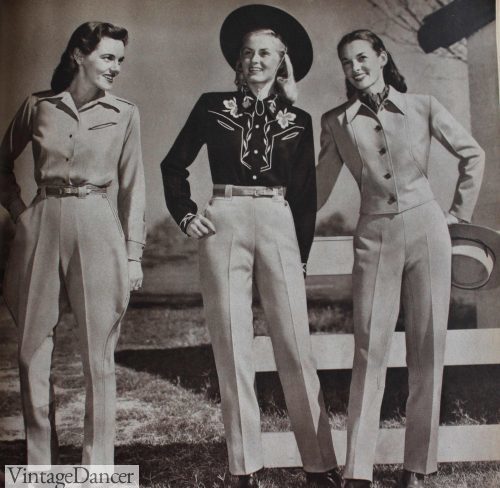
1947 Women’s Western wear
Fabrics used to make western clothing were gaberdine, rayon, cotton, and wool. In the mid to late 1940s, new leather and suede skirts, vests and jackets were worn.
Back on the homestead, amateur lady ranchers wore the first Lady Levi’s. The fashion world took notice, and in 1935, Vogue ran a story on dude ranch chic.
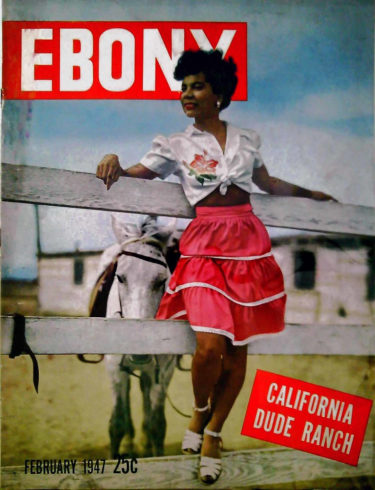
1947 cover of Ebony magazine about “California Dude Ranch” destinations
Western trousers for women were seen after WWII. Denim jeans that had been made by Levi’s before the 1940s replaced contrast stitch lines with screen printed faux stitch lines during the war. Levi’s did their part to conserve materials but did not sacrifice the Western style. More about women’s denim jeans history.
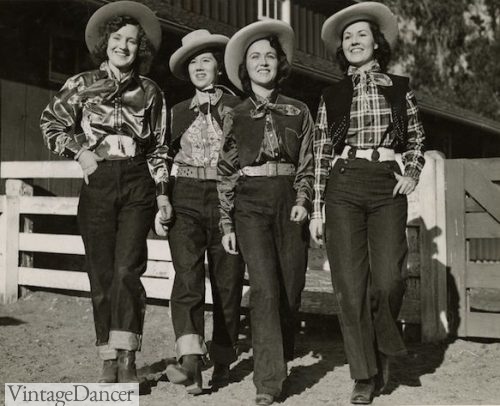
1940s Levi’s Jeans for Women Ad
In 1948, Wrangler invented zip-up jeans for women! Classic cotton, chambray, and denim shirts with metal-rim pearl snap buttons also hit the market. So did hand tooled belts, trophy buckles, and ranger sets. Western jewelry — earrings, tie bars, cufflinks, rings, and watchbands — added more details. The bolo tie came about in the late 1940s. Cuffs and spurs had not changed much since the early 1900s — there were now just more varieties.
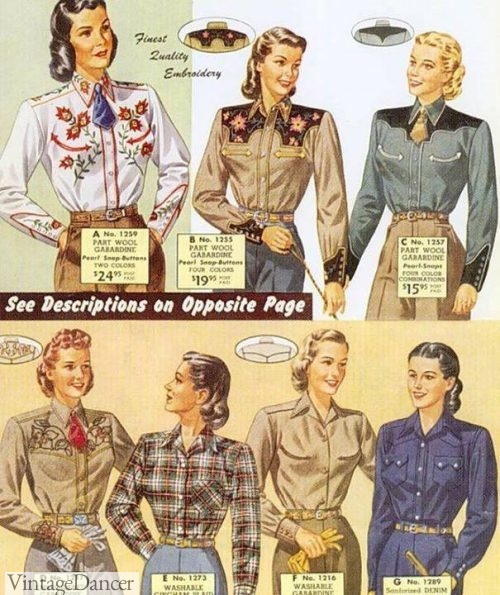
1940s Women’s western shirts,, fancy and plain
1950s Western Clothing
For women, western jeans fit the newer, slimmer silhouette of the 1950s pant. They were not skin tight like many 1950s pinup jeans are today. Instead, they followed the shape of the body starting at the high waist, full over the hips and tapered down the leg into a roll cuff. Many were lined in plaid flannel and sold with matching plaid shirts.
Learn more about the history of blue jeans for women and men.
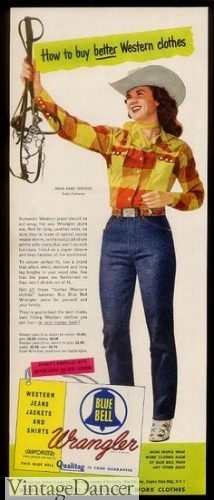
1951 Women’s Wrangler jeans ad
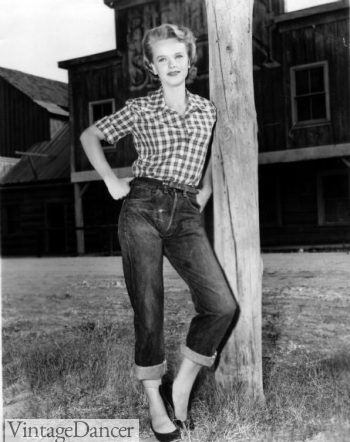
Anne Francis demos the western wear influence with plaid shirt and blue jeans. from the 1955 movie Bad Day at the Black Rock
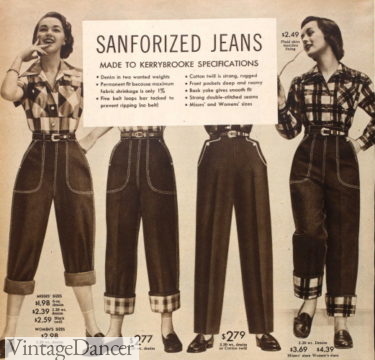
1953 blue jeans and western pants
Jeans were held up with belts by women and men. Of course they had to be western style as well. Hand tooled leather and silver belt buckles were worn by both men and women.
For the more traditional Western/Ranch wear clothing needs, women’s pants and shirts looked similar to menswear but in a more feminine cut.
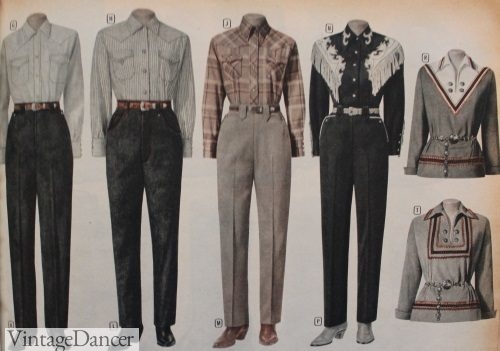
1955 Women’s western wear
Plaid shirts with snap buttons, fancy yokes, fringe, and V-front panels all made their way onto blouses and button down shirts. The non-jean pant was called the California ranch look with a full hip and a tapered, pressed leg in a heavy twill.
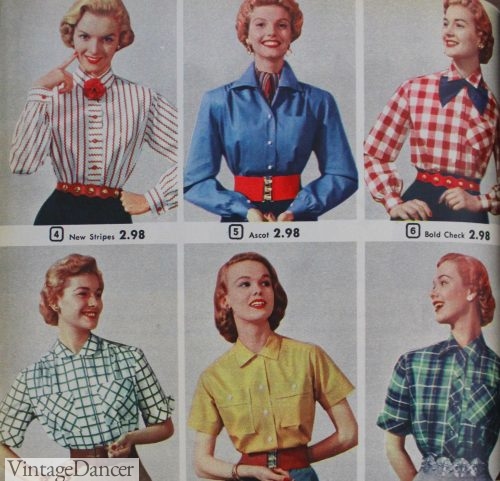
1953 Western influence is seen in these button down women’s shirts.
- 1955 women’s western wear skirts culottes jeans shirts
- 1954 fringe jackets
- 1954 western denim skirts and pants
- 1950 western jeans, pants, plaid shirts
The Western design for women influenced some skirts and dresses. I am surprised there was no more influence in terms of the details we see on shirts and pants. Most of what I see comes in the form of pattern and color. Gingham checks are very Western, as well as certain plaids. Tiered skirts or circle skirts with Western folk prints and motifs are also reminiscent of the styles worn by many female country singers.
- 1957 pink gingham dress
- 1955 Rodeo themed skirt
The western or country style became big news to women and men who enjoyed the revival of square dancing. Matching couples shirts were sold in sets. Matching women’s dresses and men’s shirts were another coordinated western look. Learn more here.
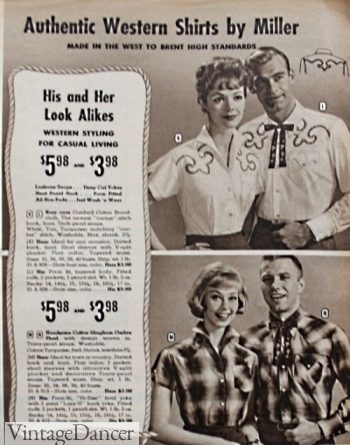
1959 Matching Western Shirts
Buy Western Style Clothing
Shop women’s vintage and retro western style clothing, handmade western wear, reproduction rodeo clothing, inspired by, and western sewing patterns. Old west to 1970s. See everything we found plus a list of more places to shop online here.
Further Reading
- 100 Years of Western Wear by Tyler Beard, Jim Arndt
- Levi Strauss and Co by Lynn Downey
- How the West was Worn – Holly George-Warren, Michelle Freedman
Debbie Sessions has been teaching fashion history and helping people dress for vintage themed events since 2009. She has turned a hobby into VintageDancer.com with hundreds of well researched articles and hand picked links to vintage inspired clothing online. She aims to make dressing accurately (or not) an affordable option for all. Oh, and she dances too.
